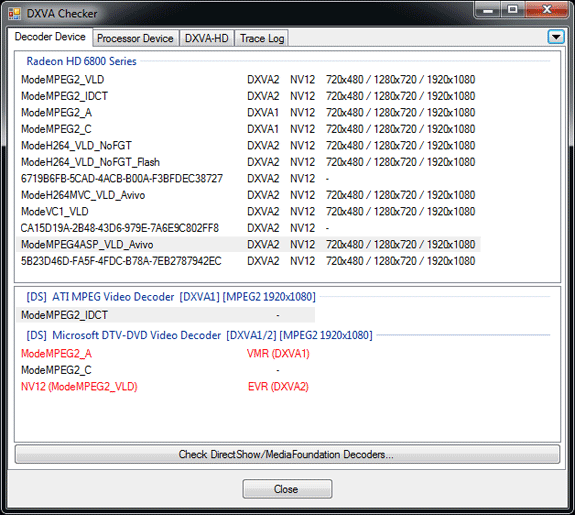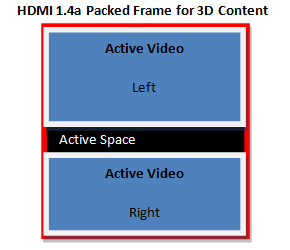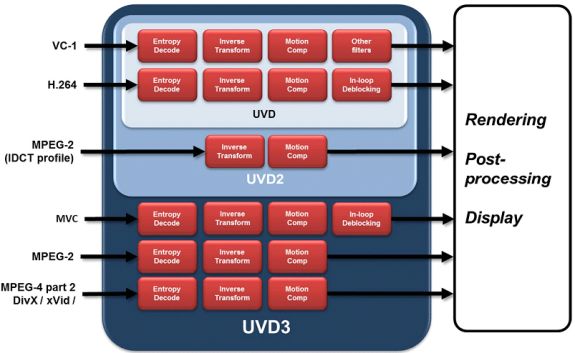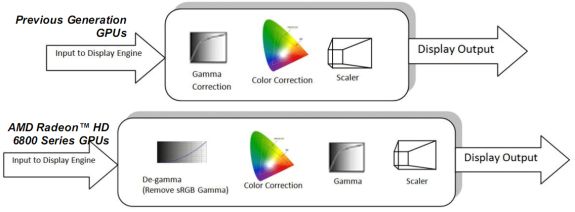AMD’s Radeon HD 6870 & 6850: Renewing Competition in the Mid-Range Market
by Ryan Smith on October 21, 2010 10:08 PM ESTSeeing the Present: HDMI 1.4a, UVD3, and Display Correction
DisplayPort wasn’t the only aspect of AMD’s display controller that got an overhaul however, AMD’s HDMI capabilities have also been brought up to modern standards. Coming from Cypress with support for HDMI 1.3, AMD now supports HDMI 1.4a on the Barts based 6800 series and presumably they will do so on the rest of the 6800 series too. With HDMI 1.4a support AMD can now support full resolution (1080p) 3D stereoscopy for movies, and 720p for games and other material that require 60Hz/eye, along with 4k x 2k resolution for monitors and TVs that have equivalent support. Unlike DP this has less to do with monitors and more to do with TVs, so the importance of this will be seen more on future AMD cards when AMD refreshes their lower-end parts that we normally use with HTPCs.
Launching alongside support for displaying full resolution 3D stereoscopic video is the hardware necessary to decode such video, in the form of the latest version of AMD’s Unified Video Decoder: UVD3. The last time UVD received a major update was with UVD2, which launched alongside the Radeon HD 4000 series and added partial MPEG-2 decoding support by moving IDCT and MoComp from shaders in to the UVD fixed function hardware.
With the Radeon 6800 series AMD is releasing UVD3, which like UVD2 before it builds on the existing UVD feature set. UVD3 is adding support for 3 more-or-less new codecs: MPEG-2, MVC, and MPEG-4 ASP (better known as DivX/XviD). Starting with MPEG-4 ASP, it’s the only new codec in supported by UVD3 that’s actually new, as previously all MPEG-4 ASP decoding was done in software when it came to AMD GPUs. With UVD3 AMD can now completely offload MPEG-4 ASP decoding to the GPU, bringing forth the usual advantages of greatly reducing the amount of work the CPU needs to do and ideally reducing power consumption in the process.
AMD adding MPEG-4 ASP support gives us an interesting chance to compare and contrast them to NVIDIA, who added similar support a year ago in the GT21x GPUs. AMD is a good bit behind NVIDIA here, but they’re making up for it by launching with much better software support for this feature than NVIDIA did; NVIDIA still does not expose their MPEG-4 ASP decoder in most situations, and overall did a poor job of advertising it. When we talked with DivX (who is AMD’s launch partner for this feature) they didn’t even know that NVIDIA had MPEG-4 ASP support. Meanwhile AMD is launching with DivX and had a beta version of the DivX codec with UVD3 support ready to test, and furthermore AMD is fully exposing their MPEG-4 ASP capabilities in their drivers as we see in this DXVA Checker screenshot.

The only downside at this time is that even with Microsoft’s greater focus on codecs for Windows 7, Windows 7 doesn’t know what to do with DXVA acceleration of MPEG-4 ASP. So while Win7 can play MPEG-4 ASP in software, you’re still going to need a 3rd party codec like the DivX codec to get hardware support for MPEG-4 ASP.
The other bit worth mentioning is that while AMD is launching support for MPEG-4 ASP decoding here on the 6800 series, much like HDMI 1.4a it’s not going to be a big deal for the 6800 series market. MPEG-4 ASP is a fairly lightweight codec, so support for it is going to be a bigger deal on low-end products, particularly AMD’s APUs if Llano and Bobcat end up using UVD3, as MPEG-4 ASP decoding in software requires a much greater share of resources on those products.
Up next is MPEG-2, which has been a codec stuck in limbo for quite some time over at AMD. MPEG-2 is even older and easier to decode than MPEG-4 ASP, and while GPUs have supported MPEG-2 decode acceleration as early as last decade, CPUs quickly became fast enough that when combined with low levels of hardware decode acceleration (inverse discrete cosine transform) was more than enough to play MPEG-2 content. Thus AMD hasn’t done much with MPEG-2 over the years other than moving IDCT/MoComp from the shaders to UVD for UVD2.
Because of the similarities between MPEG-4 ASP and MPEG-2, when AMD added support for full MPEG-4 ASP decode acceleration they were able to easily add support for full MPEG-2 decode acceleration, as they were able to reuse the MPEG-4 ASP entropy decode block for MPEG-2. As a result of including full MPEG-4 ASP decode acceleration, AMD now supports full MPEG-2 decode acceleration. Even more so than MPEG-4 ASP however, the benefits for this are going to lie with AMD’s low-end products where getting MPEG-2 off of the CPU should be a boon for battery life.

The final addition to UVD3 is support for Multiview Video Coding, which isn’t a new codec per se, but rather is an extension to H.264 for 3D stereoscopy. H.264 needed to be amended to support the packed frame formats used to store and transmit 3D stereoscopic videos, so with UVD3 AMD is adding support for MVC so that UVD can handle Blu-Ray 3D.
Finally, coupled with support for new codecs and new display outputs in AMD’s display controller is a refinement of AMD’s existing color correction capabilities in their display controller. Cypress and the rest of the 5000 series could do color correction directly on their display controllers, but they could only do so after gamma correction was applied, meaning they had to work in the non-linear gamma color space. Technically speaking this worked, but color accuracy suffered as a result. With the 6800 series’ new display controller, AMD can now perform color calibration in linear space by converting the image from gamma to linear color space for the color correction, before converting it back to gamma color space for display purposes.
As color correction is being used to correct for wide-gamut monitors the importance of this change won’t be seen right away for most users, but as wide-gamut monitors become more widespread color correction becomes increasingly important since wide-gamut monitors will misinterpret the normal sRGB colorspace that most rendering is done in.












197 Comments
View All Comments
StriderGT - Friday, October 22, 2010 - link
I agree with you that the inclusion of the FTW card was a complete caving and casts shadows to a so far excellent reputation of anandtech. I believe the whole motivation was PR related, retaining a workable relation with nvidia, but was it worth it?!Look how ugly can this sort of thing get, they do not even include the test setup... Quote from techradar.com:
We expected the 6870 to perform better than it did – especially as this is essentially being pitched as a GTX 460 killer.
The problem is, Nvidia's price cuts have made this an impossible task, with the FTW edition of the GTX 460 rolling in at just over £170, yet competently outperforming the 6870 in every benchmark we threw at it.
In essence, therefore, all the 6870 manages is to unseat the 5850 which given its end of life status isn't too difficult a feat. We'd still recommend buying a GTX 460 for this sort of cash. All tests ran at 1,920 x 1,080 at the highest settings, apart from AvP, which was ran at 1,680 x 1,050.
http://www.techradar.com/reviews/pc-mac/pc-compone...
oldscotch - Friday, October 22, 2010 - link
...where a Civilization game would be used for a GPU benchmark.AnnihilatorX - Friday, October 22, 2010 - link
It's actually quite taxing on the maps. It lags on my HD4850.The reason is, it uses DX 11 DirectCompute features on texture decompression. The performance is noticeably better on DX11 cards.
JonnyDough - Friday, October 22, 2010 - link
"Ultimately this means we’re looking at staggered pricing. NVIDIA and AMD do not have any products that are directly competing at the same price points: at every $20 you’re looking at switching between AMD and NVIDIA."Not when you figure in NVidia's superior drivers, or power consumption...depending on which one matters most to you.
Fleeb - Friday, October 22, 2010 - link
I looked at the load power consumption charts and saw the Radeon cards are better in this department and I don't clearly understand your statement. Did you mean that the nVidia cards in these tests should be better because of superior power consumption or that their power consumption is superior in a sense that nVidia cards consume more power?jonup - Friday, October 22, 2010 - link
I think he meant the nVidia has better drivers but worse power consumption. So it all depends on what you value most. At least that's how I took it.zubzer0 - Friday, October 22, 2010 - link
Great review!If you have the time I would be wery happy if you test how well these boards do in Age of Conan DX10?
Some time ago you included (feb. 2009) Age of Conan in your reviews, but since then DX10 support was added to the game. I have yet to see an official review of the current graphics cards performance in AoC DX10.
Btw. With the addon "Rise of the godslayer" the graphics in the new Khitai zone are gorgeous!
konpyuuta_san - Friday, October 22, 2010 - link
In my case (pun intended), the limiting factor is the physical size of the card. I've abandoned the ATX formats completely, going all out for mini-ITX (this one is Silverstone's sugo sg06). The king of ITX cases might still be the 460, but this is making me feel a bit sore about the 460 I'm just about to buy. Especially since the 6870 is actually only $20 more than the 6850 where I live and the 6850 is identically priced to the 460. There's just no way I can fit a 10.5 inch card into a 9 inch space. The 9 inch 6850 would fit, but there's a large radiator mounted on the front of the case, connected to a cpu water cooling block, that will interfere with the card. I've considered some crazy mods to the case, but those options just don't feel all that attractive. The GTX460 is a good quarter inch shorter and I'm getting a model with top-mounted power connectors so there's ample room for everything in this extremely packed little gaming box. I'm still kind of trying to find a way to put a 6850 in there (bangs and bucks and all that), which leads to my actual question, namely:The issue of rated power consumption; recommended minimum for the 460 is 450W (which I can support), but for the 6850 it's 500W (too much). How critical are those requirements? Does the 6850 really require a 500W supply? Despite having lower power consumption than the 460?! Or is that just to ensure the PSU can supply enough amps on whatever rail the card runs off? If my 450W SFF PSU can't supply the 6850, it really doesn't matter how much better or cheaper it is ....
joshua4000 - Friday, October 22, 2010 - link
let me get this straigt, fermi was once too expensive to manufacture due to its huge die and stuff but its striped down versions sell for less and outpace newley released amd cards (by a wide margin when looked at the 470)amds cheaper to manufacture cards (5xxx) on the other hand came in overpriced once the 460 had been released (if they havent been over priced all along...), still, the price did not drop to levels nvidia could not sell products without making a loss.
amd has optimised an already cheap product price wise, that does not outperforme the 470 or an oced 460 while at the same time selling for the same amount $.
considering manufacturing and pricing of the 4870 in its last days, i guess amd will still be making money out of those 6xxx when dropping the price by 75% msrp.
NA1NSXR - Friday, October 22, 2010 - link
Granted there have been a lot of advancements in the common feature set of today's cards and improvement in power/heat/noise, but the absolute 3D performance has been stagnant. I am surprised the competition was called alive and well in the final words section. I built my PC back in 7/2009 using a 4890 which cost $180 then. Priced according to the cards in question today, it would slot in roughly the same spot, meaning pretty much no performance improvement at all since then. Yes, I will repeat myself to ward off what is certainly coming - I know the 4890 is a pig (loud, noisy, power hungry) compared to the cards here. However, ignoring those factors 3D performance has barely budged in more than a year. Price drops on 5xxx was a massive disappointment for me. They never came in the way I thought was reasonable to expect after 4xxx. I am somewhat indifferent because in my own PC cycle I haven't been in the market for a card, but like I said before, disappointment in the general market and i wouldn't really agree with the statement that competition is alive and well, at least in any sense that is benefiting people who weight performance more heavily in criteria.